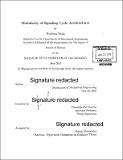Modularity of signaling cycle architectures
Author(s)
Shah, Rushina (Rushina Jaidip)
DownloadFull printable version (5.331Mb)
Other Contributors
Massachusetts Institute of Technology. Department of Mechanical Engineering.
Advisor
Domitilla Del Vecchio.
Terms of use
Metadata
Show full item recordAbstract
This work analyzes various topologies of phosphorylation cycles with respect to two properties: modularity, that is the ability to be treated as separate functional units irrespective of interconnections, and insulation, the ability to attenuate the effect of retroactivity applied by downstream systems and hence facilitate modular design in synthetic biology. Phosphorylation cycles are ubiquitous in cell signal-transduction systems. Single phosphorylation cycles have been found to have insulating properties that reduce the effect of downstream loads. The analysis of these cycles is thus important in understanding their role in signaling systems in the cell, as well as to design modular units in synthetic biology. In this work, these systems are treated as input-output systems, and singular perturbation methods based on their fast time-scale of operation are used to develop a framework to analyze their retroactivity attenuation properties. Single phosphorylation cycles with kinase input show a trade-off in attenuating retroactivity to the input and output. Using this framework, we found that a cascade of phosphorylation cycles break this trade-off, and further, that there is a optimal number of cycles that maximally extends the linear operating region of the input while keeping the desired retroactivity properties, when a common phosphatase is used. A double phosphorylation cycle with kinase input shows similar retroactivity attenuation properties as the single cycle, but shows a non-linear ultrasensitive input-output response. Single and double phosphorylation cycles with the substrate as input show no modularity properties. These findings provide design strategies for insulation devices for synthetic biology applications, as well as a test for whether such naturally occurring systems can be considered modular.
Description
Thesis: S.M., Massachusetts Institute of Technology, Department of Mechanical Engineering, 2016. Cataloged from PDF version of thesis. Includes bibliographical references (pages 97-99).
Date issued
2016Department
Massachusetts Institute of Technology. Department of Mechanical EngineeringPublisher
Massachusetts Institute of Technology
Keywords
Mechanical Engineering.